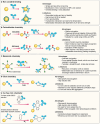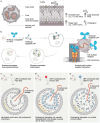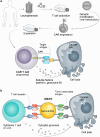Antibody-Nanoparticle Conjugates in Therapy: Combining the Best of Two Worlds
- PMID: 40051146
- PMCID: PMC12001320
- DOI: 10.1002/smll.202409635
Antibody-Nanoparticle Conjugates in Therapy: Combining the Best of Two Worlds
Abstract
Monoclonal antibodies (mAbs) and antibody fragments have revolutionized medicine as highly specific binding agents and inhibitors. At the same time, several types of nanomaterials, including liposomes, lipid nanoparticles (NPs), polymersomes, metal and metal oxide NPs, and protein nanostructures, are increasingly utilized and explored for therapeutic potential due to their versatility, chemical and physical properties, and tunability. However, nanomaterials alone often lack specificity, leading to relatively low efficacy and/or high toxicity. To address this problem, a rapidly emerging area is antibody-nanomaterial conjugates (ANCs), which combine the precise targeting specificity of antibodies with the effector functionality of the nanomaterial. In this review, we give a brief introduction to mAbs and major conjugation techniques, describe major classes of nanomaterials being studied for therapeutic potential, and review the literature on ANCs of each class. Special focus is given to emerging applications including ANCs addressing the blood-brain barrier, ANCs delivering nucleic acids, and light-activated ANCs. While many disease targets are related to cancer, ANCs are also under development to address autoimmune, neurological, and infectious diseases. While important challenges remain, ANCs are poised to become a next-generation therapeutic technology.
Keywords: antibody; bioconjugation; liposome; mAb; nanoparticle.
© 2025 The Author(s). Small published by Wiley‐VCH GmbH.
Conflict of interest statement
IAC is a co‐founder of Paralos Bioscience, Inc. advancing phage‐based delivery solutions.
Figures








Similar articles
-
Evaluation of Cellular Targeting by Fab' vs Full-Length Antibodies in Antibody-Nanoparticle Conjugates (ANCs) Using CD4 T-cells.Bioconjug Chem. 2022 Mar 16;33(3):486-495. doi: 10.1021/acs.bioconjchem.2c00024. Epub 2022 Feb 9. Bioconjug Chem. 2022. PMID: 35139308 Free PMC article.
-
EGFR targeting for cancer therapy: Pharmacology and immunoconjugates with drugs and nanoparticles.Int J Pharm. 2021 Jan 5;592:120082. doi: 10.1016/j.ijpharm.2020.120082. Epub 2020 Nov 12. Int J Pharm. 2021. PMID: 33188892 Review.
-
Optimizing Conjugation Chemistry, Antibody Conjugation Site, and Surface Density in Antibody-Nanogel Conjugates (ANCs) for Cell-Specific Drug Delivery.Bioconjug Chem. 2023 Mar 27:10.1021/acs.bioconjchem.3c00034. doi: 10.1021/acs.bioconjchem.3c00034. Online ahead of print. Bioconjug Chem. 2023. PMID: 36972480 Free PMC article.
-
Immunoconjugates for Cancer Targeting: A Review of Antibody-Drug Conjugates and Antibody-Functionalized Nanoparticles.Curr Med Chem. 2021;28(13):2485-2520. doi: 10.2174/0929867327666200525161359. Curr Med Chem. 2021. PMID: 32484100 Review.
-
Recent Advances in the Generation of Antibody-Nanomaterial Conjugates.Adv Healthc Mater. 2018 Jan;7(1). doi: 10.1002/adhm.201700607. Epub 2017 Sep 29. Adv Healthc Mater. 2018. PMID: 28961378 Review.
Cited by
-
Higher order receptor clustering due to the IgG3 subclass is necessary for TLR4 signaling and tolerance induction by novel human anti-TLR4 antibodies.MAbs. 2025 Dec;17(1):2515415. doi: 10.1080/19420862.2025.2515415. Epub 2025 Jun 4. MAbs. 2025. PMID: 40464120 Free PMC article.
-
The Role of LAIR1 as a Regulatory Receptor of Antitumor Immune Cell Responses and Tumor Cell Growth and Expansion.Biomolecules. 2025 Jun 13;15(6):866. doi: 10.3390/biom15060866. Biomolecules. 2025. PMID: 40563506 Free PMC article. Review.
-
Discovery of a novel chalcone-derived covalent Keap1 binder for mitigating cisplatin-induced mitochondrial dysfunction and nephrotoxicity.Redox Biol. 2025 Sep;85:103737. doi: 10.1016/j.redox.2025.103737. Epub 2025 Jun 21. Redox Biol. 2025. PMID: 40592144 Free PMC article.
References
-
- Strebhardt K., Ullrich A., Nat. Rev. Cancer 2008, 8, 473. - PubMed
-
- Sharmiladevi P., Girigoswami K., Haribabu V., Girigoswami A., Mater. Adv. 2021, 2, 2876.
Publication types
MeSH terms
Substances
Grants and funding
LinkOut - more resources
Full Text Sources

